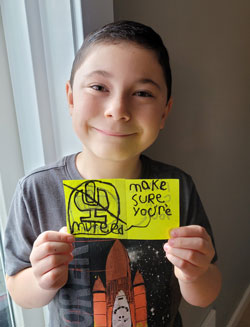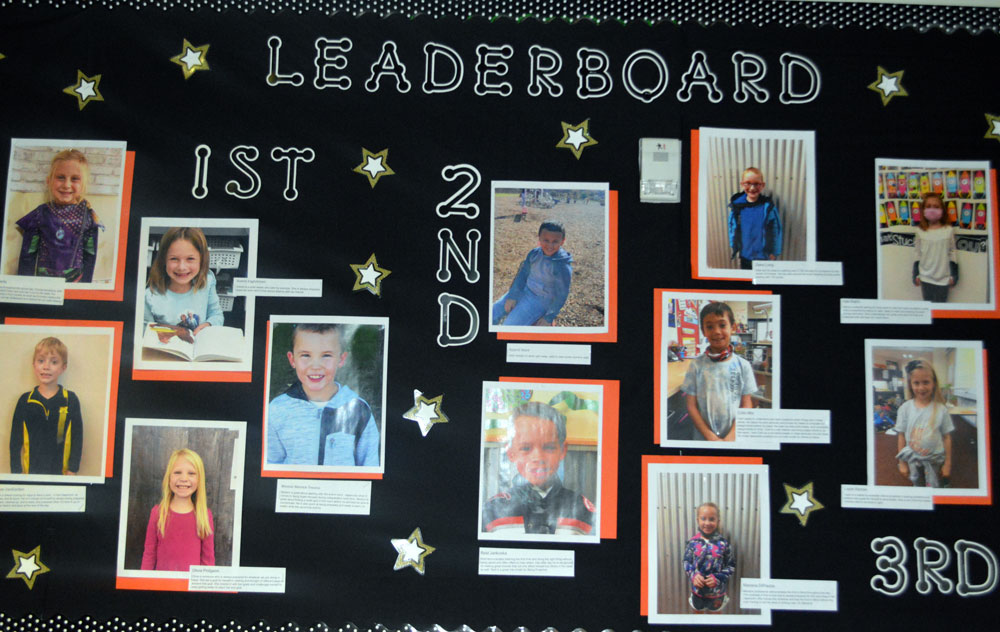Byron Center —Countryside Elementary School second-grader Greg Brinkert put a big blanket over his kitchen table to make his own fort-style workspace during virtual learning. Principal Jolynne Knowlton noticed how well he was doing on Zoom while he read to his class.
“You were knocking it out of the park with virtual school,” Knowlton told Greg during the first day back to in-person instruction following two weeks remote to slow the spread of COVID-19. “That was Greg being proactive,” she told fellow second-graders.

Greg agreed he was thinking ahead in not only having a space prepared for learning, but also in another way: “I wanted to eat snacks in there,” he said.
“Proactive” perhaps isn’t a word commonly used by second-graders, but at Countryside it’s part of the lingo students are learning about leadership. Everyone can be a leader in proactively working toward goals, they’ve learned, along with other habits that make up the Leader in Me program.
Countryside, Brown and Marshall elementary schools are piloting the program this year as a way to instill in students a sense of leadership and independence.
“We’ve noticed over the past five years or more that a lot of times students are apathetic. They couldn’t be independent. They always needed someone there with them. They weren’t motivated,” Knowlton said, noting that she and other administrators were searching for a new social-emotional program to address these issues.
“It does not matter who you are, where you come from or what your strengths are. Every single person is a leader. They can be leaders by example.”
— Principal Jolynne Knowlton
Knowlton had participated in a workshop on how students deal with trauma, and studied Leader in Me. She and other educators visited a school in Kalamazoo that has implemented the program.
“What we saw the kids doing just blew us out of the water. It was amazing how independent they were,” she said.

How to Be a Leader
Administrators studied the book “The Leader in Me” by Steven Covey, and the seven habits of leadership it details. The program was developed by a principal and teachers who wanted to teach their students life skills such as leadership, responsibility, accountability, problem solving, adaptability and effective communication. They include:
- Habit 1: Be Proactive (You’re in Charge)
- Habit 2: Begin With the End in Mind (Have a Plan)
- Habit 3: Put First Things First (Work First, Then Play)
- Habit 4: Think Win-Win (Everyone Can Win)
- Habit 5: Seek First to Understand, Then to Be Understood (Listen Before You Talk)
- Habit 6: Synergize (Together Is Better)
- Habit 7: Sharpen the Saw (Balance Feels Best)
Since September, teachers have worked to ingrain the habits into the curriculum and make it a part of the language of the school in the classroom, hallways, cafeteria and playground.
“We hear kids talking about it in the hallways,” Knowlton said. “They are using the language without being prompted. I have kids stop me during parent pickup almost every day, to tell me how they are beginning with the end in mind, doing first things first or being proactive.”
In teacher Cindy Viveen’s second-grade class, students have responded positively.
“I see it all day long,” she said. “I use the vocabulary a lot, and I’ve started to see them use it a lot with each other … It generates discussions and helps them start to identify within themselves that they all have that trait or skill that is unique to them, that they are very good at that (and) they can share with others.”
Second-grader Ethan Vogt explained how he begins with the end in mind with his reading goals. “You think of your end goal and then you just keep doing little steps until you get to that goal,” he said. “My big goal in reading was to get 60 Reading Counts points.”
Ethan also has been proactive about making sure Zoom classes run smoothly. “In my class, my one friend forgot where the mute button was. I made a little picture,” he said, showing a picture of the mute microphone icon he drew.
“It helps them start to identify within themselves that they all have that trait or skill that is unique to them, that they are very good at that (and) they can share with others.”
— second-grade teacher Cindy Viveen
Second-grader Isaiah Rop agreed that working toward a goal is part of being a leader. “You can try something new, and if you do something every single day you can get better with it,” he said.
Viveen said Isaiah also went above and beyond as a leader on the playground to include a student who was struggling to fit in. Isaiah started including him in a regular game of tag that brought many friends together.
Knowlton is head of the district’s Diversity Committee, and said Leader in Me fits in well with its goals “because it does not matter who you are, where you come from or what your strengths are. Every single person is a leader. They can be leaders by example,” she said. “Leader in Me automatically gives you a voice without singling you out.”
Knowlton said she’s already seen students taking ownership of their abilities. “During virtual school, I had multiple emails from parents about how independent their children are.”










